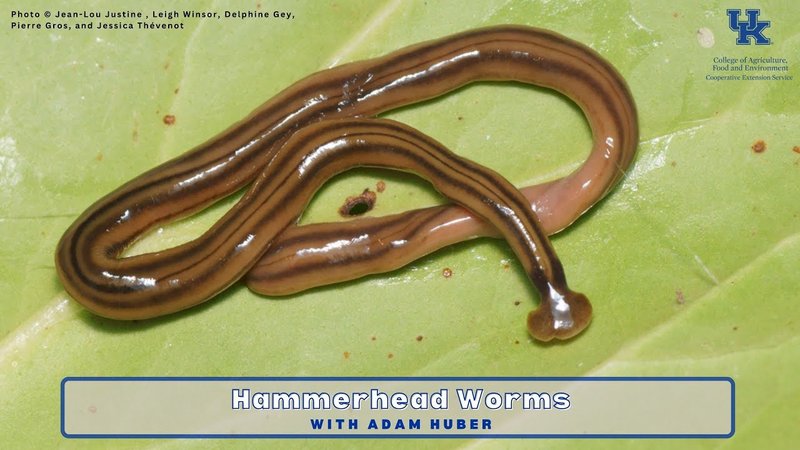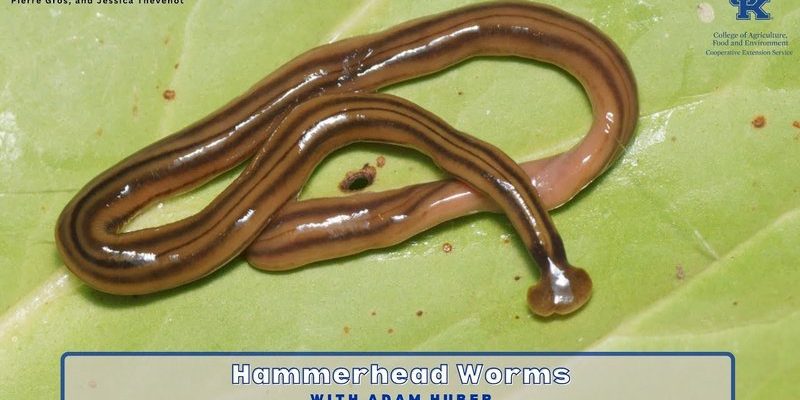
In the world of soil-dwelling organisms, hammerhead worms are quite fascinating. They can reproduce in ways that seem almost magical. Knowing how they breed can help gardeners manage their populations effectively, so you can keep your garden healthy and thriving. So, let’s dive into the world of hammerhead worm reproduction and see what you need to know.
What Are Hammerhead Worms?
Hammerhead worms, scientifically known as *Bipalium spp.*, are a type of flatworm. They’re usually found in warm, moist environments and can often be spotted in gardens or tropical areas. With their long, flat bodies and unique hammer-like head shapes, they’re quite different from your typical earthworm.
These creatures are carnivorous and primarily feed on other worms, slugs, and sometimes even small insects. You might be wondering if they’re harmful to your garden. Well, while they do help control certain pest populations, their predilection for earthworms can be problematic, as it can disrupt the ecosystem of your soil.
What’s really interesting, though, is how they reproduce. Unlike many garden creatures, hammerhead worms are hermaphrodites, meaning they possess both male and female reproductive organs. This unique feature allows them to mate with any other hammerhead worm they encounter. It’s like having the ability to choose your partner in a sea of potential mates!
How Do Hammerhead Worms Reproduce?
Let me explain how hammerhead worms go about their reproduction. When two hammerhead worms meet, they engage in a rather complex mating dance. They’ll align themselves and exchange sperm, which can be quite a sight! After mating, they each store the sperm for fertilization later.
Once they’ve secured their genetic material, these worms can produce a significant number of eggs—sometimes more than 1,000 at a time! This process usually occurs in warmer months when conditions are just right. You might compare their breeding to a wild party where everyone shows up and leaves behind a big surprise—lots of little worm babies.
After a few weeks, the eggs hatch into tiny, immature versions of hammerhead worms. These little creatures are called juveniles, and they’ll continue to grow and develop into adults, perpetuating the cycle. Knowing this can be pretty crucial for gardeners who want to control their populations effectively.
The Life Cycle of Hammerhead Worms
The life cycle of hammerhead worms can be fascinating to observe. After the eggs hatch, those tiny juveniles resemble miniature versions of their parents. They may even have a bit of an adventurous spirit, venturing out to find food and shelter. This initial stage is all about growth and survival, as they need to find food quickly.
As they mature, hammerhead worms develop their distinctive hammer-shaped heads. This unique shape helps them navigate their environment better and hunt for prey. Since they’re primarily carnivorous, they will actively seek out earthworms and other soft-bodied creatures to feast on, making them effective predators in your garden.
You might be surprised to learn that their life span can range anywhere from several months to a few years, depending on environmental conditions. This means that if you have a few hammerhead worms in your garden, they could potentially stick around for a while and start a family of their own!
Impacts on Your Garden
Now, let’s talk about why all this matters for gardeners like you. Hammerhead worms can have both positive and negative impacts on your garden. On the one hand, they help control populations of certain pests, but on the other, their appetite for earthworms can harm the soil’s health.
Earthworms are vital for a healthy garden because they aerate the soil and help decompose organic matter. So, if hammerhead worms become too abundant, they can disrupt this balance. If you notice an increase in their numbers, you might want to take some action to manage their population.
For instance, maintaining healthy soil and ensuring your garden doesn’t become overly moist can help deter hammerhead worms. They thrive in damp environments, so keeping your soil slightly drier might make it less inviting for them.
Managing Hammerhead Worm Populations
If you’re dealing with an influx of hammerhead worms, here are a few strategies to help manage their populations without harming your garden:
- Reduce Moisture: Since hammerhead worms love moist conditions, watering your garden carefully can help. Ensure the soil drains well.
- Hand Removal: If you see them, you can remove them by hand. Wearing gloves, pick them up and relocate them away from your garden.
- Encourage Beneficial Species: Attracting birds and other natural predators can help keep hammerhead worm numbers in check.
- Avoid Over-Fertilizing: Excess nutrients can encourage unwanted pests, including hammerhead worms.
By being proactive, you can help maintain a balanced ecosystem in your garden and ensure that your plants thrive.
Final Thoughts on Hammerhead Worm Reproduction
Understanding hammerhead worm reproduction can provide valuable insights for gardeners. While they have intriguing traits, their impact on the garden ecosystem is something to consider. By being aware of their breeding habits and life cycle, you can better manage their populations and protect your garden’s health.
Honestly, it’s all about balance. A few hammerhead worms can be beneficial, but too many can tip the scales in the wrong direction. Keep an eye on them, manage their numbers, and you’ll be well on your way to cultivating a flourishing garden. Remember, knowledge is power, especially when it comes to maintaining the delicate balance of nature in your backyard.

